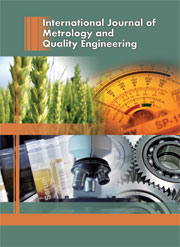Article contents
Line scale measurement using image registration
Published online by Cambridge University Press: 07 November 2013
Abstract
Currently, most advances in dimensional metrology might be seen by the evolution of non-contact measurement (optical measurements), in order to provide traceability for different areas that needs to calibrate microscopes or optical measure machines. In a similar way, the use of image processing techniques for the measuring of objects has been the subject of recent studies in computer vision and image metrology. In the attempt to meet the requirements and demands for high accuracy dimensional metrology with image processing techniques, this work will present the application of the image registration technique for the measurement of line scales. In the conventional calibration, the scales are measured in pre-established points, generally in intervals of 10% of the total scale length. With this application, it becomes possible to provide results for all the scale marks quickly and automatically, whereas in the conventional method it would require more time and, thus, a higher cost for the fulfillment of this measurement.
- Type
- Research Article
- Information
- International Journal of Metrology and Quality Engineering , Volume 4 , Issue 2 , 2013 , pp. 121 - 125
- Copyright
- © EDP Sciences 2013
References
- 5
- Cited by




